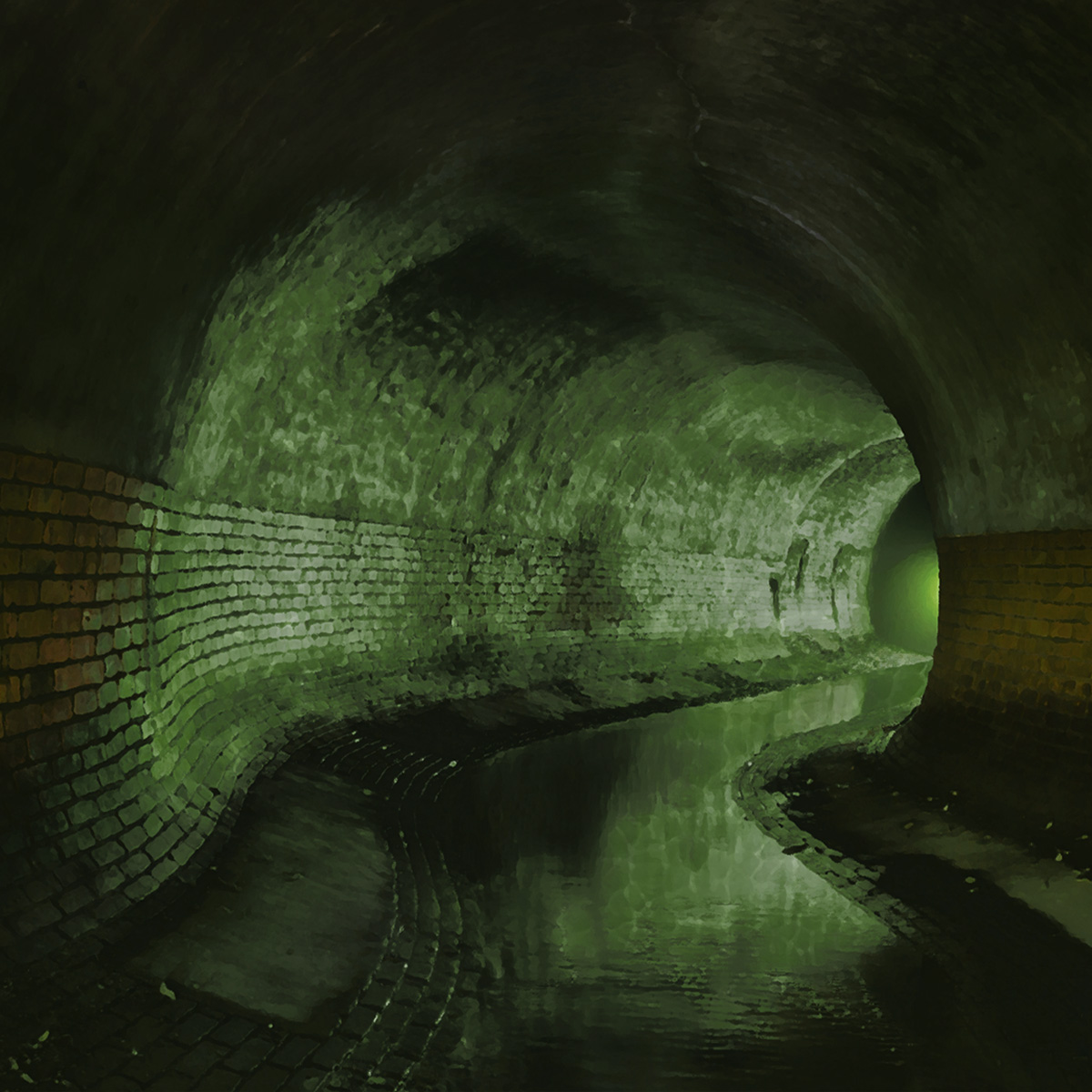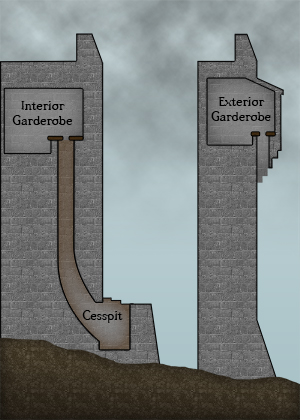
In most of our games, Game Masters (GMs) tend to handwave away most bodily functions. After all, in most cases, we’re here for the action and not graphic descriptions of individuals urinating or defecating. However, knowing how and where they deal with their waste is essential when describing medieval-based construction and large collections of people or monsters. Waste management often defined how and where structures were built and usually only appears in a game when we want to include a sewer for a city dungeon crawl.
There are many varied solutions to waste management in medieval society, but the truth is that by modern standards, medieval cities were absolutely foul. That is why we often wave away the details and just assume there’s a sewer system and that creatures and people deal with those functions on their own. I’m not suggesting you need to include descriptions of characters defecating or time for them to do so, but you should know how waste is dealt with in the town, city, or even dungeon they happen to be adventuring in. Are there sewers? Chamber Pots? Or does everyone carry their waste to a midden heap, toss it in the gutters, or dump it in a nearby river?
Walking through the streets of a medieval city was a filthy experience. Individuals were likely to urinate in the road rather than find a privy or latrine. Inhabitants would dump chamber pots and waste directly into the streets below, leaving piles of excrement and filth. If a traveler wasn’t quick on their feet, they might get doused with the contents of a chamberpot dumped from a window. And everywhere one turned, the smell of human waste would permeate the air.
Medieval Toilets
The flush toilet that we use today began to appear in everyday use around the late 18th century. Before that, dedicated toilets took the form of latrines, outhouses, garderobes, and chamber pots. A simple outhouse works well where there’s room, such as on a farm or in a small village. A deep hole with a raised seat (sometimes enclosed for “comfort”) is all you’d need, though it occasionally needs to be cleaned out. Larger settlements and military camps might have a dedicated latrine. A single location that everyone uses, often located at the edge of a river or cesspool. Rivers were often used to move waste away from the settlement or camp and mitigate the stench and diseases that permeate stagnant cesspools.

In castles and wealthy homes, a garderobe might be included in the building’s construction. A garderobe is an architectural feature that extends beyond a building’s wall, with a hole to drop waste to a pit or cesspool below. Inside, users would often have a seat or bench with a hole for urinating or defecating. Additionally, cleaning staff could collect chamber pots and dump them into the garderobe rather than through a window or carrying them to the midden. In castles, the garderobe usually extended over the outer wall to dump waste directly into the moat. Because of this, castle moats were often stagnant cesspools rather than clean water features. In some cases, a garderobe may overhang running water, such as a stream or river, which would remove the waste and lessen the smell.
Cities are a different story altogether. With high populations, often living on top of each other, there’s little room for outhouses or garderobes. In most dwellings, people used chamber pots, small ceramic, metal, or wooden vessels kept in the bedroom for waste purposes. These small containers would have to be emptied daily, sometimes into a nearby midden or cesspit, but more often by dumping them out the window to the street below. Some city locations would also have latrines or privies, which consisted of a long bench with multiple holes over a cesspit, midden, or stream. Roman public latrines often had up to 20 seats arranged in a single room while water constantly ran beneath them and carried waste to the nearest sewer or river.
Cesspits and Middens
Most people in the Middle Ages did not have the luxury of a garderobe. Instead, they had to settle for more communal facilities, such as cesspits. A cesspit was simply a hole in the ground for collecting waste. Cesspits could be small and covered by a single privy or outhouse or quite large and fed by several latrines or drains. Since excrement would stagnate and pile up in the hole, cesspits needed to be emptied occasionally. Those employed to dig out cesspits were known as “gong farmers,” “muckrakers,” or “nightmen,” as they were only allowed to work at night and received as much as three times the wages of unskilled laborers.
Cesspits are prime breeding grounds for creatures like carrion crawlers, slimes, oozes, and otyughs.
Smaller cesspits would be dug out and carried to a location away from the settlement, usually to a larger cesspit, dumping ground, or midden. In addition to human waste, these larger cesspits would often be used to dump trash, kitchen waste, and even occasional corpses. Stories also exist of people falling into cesspits and drowning in excrement. In a fantasy setting, cesspits are prime breeding grounds for creatures like carrion crawlers, slimes, oozes, and otyughs.
Gutters and Sewers
Generally, people want to be as far away from waste and excrement as possible. Many settlements were built near rivers as a means of flushing out human waste in addition to providing a fresh water source. Before we understood the environmental impact of contaminating water sources, that was a perfectly acceptable method of moving waste away from human populations. However, there still needed to be a way to get waste to the river or local cesspool.
In modern parlance, we have a common saying that “Shit rolls downhill.” While this phrase now generally means that those in charge pass problems down to their subordinates, it used to have a very literal meaning. Many communities were built on hills or backed against steep dropoffs so that waste would flow down to rivers or cesspools below. That kept waste away from homes but often made such hills quite filthy.
The earliest sewers used existing streams and waterways to move waste.
Medieval cities often used gutters in the streets to move waste to lower points and eventually to a cesspool, sewer, or river. For wastewater run-off, open drains and gutters ran along the center of some streets, also known as “kennels” or split streets. Settlements often used existing streams and waterways to collect waste and move it into nearby rivers or harbors. These natural waterways were eventually covered over to function as shallow sewers.

One of the world's earliest sewage systems, the Cloaca Maxima, was first built by the Etruscans as an open-air canal. Eventually, the Romans covered the channel and began to build over it, turning it into a closed sewer system for Rome. The aqueducts that supplied water to Rome were channeled through the public baths, fountains, and private houses before flowing into the sewers. The continuous running water supply helped remove wastes and keep the sewers clear of obstructions. In the late 1st century, Pliny the Elder describes the early Cloaca Maxima as “large enough to allow the passage of a wagon loaded with hay.”
Aside from the Cloaca Maxima, the sewer concept that we usually use in gaming, a large tunnel that adventurers could walk through, didn’t exist in widespread use in the middle ages. The first sewer system in Paris was built in the thirteenth century and consisted of open troughs that ran down the center of each cobblestone road. The first underground sewer in Paris was built in 1370 beneath the Rue Montmartre and drained into a tributary of the Seine River. The sewer system expanded slowly over the next 400 years but largely lacked coverage and suffered from disrepair.
Large, dungeon-like sewer tunnels didn’t exist in widespread use in the middle ages.
We love the concept of a large, extensive sewer system to run urban dungeon crawls or to hide the local thieves ’ guild. As long as you understand that including a massive sewer system in your campaign changes the technology level for waste management. In most cases, this is perfectly fine, and you might as well include some rudimentary plumbing for the buildings, using earlier Roman concepts rather than medieval technology. Ultimately, however, the sewer still needs to move waste somewhere, whether into a bottomless abyss or out to the river or harbor.
Plumbing
In most game worlds, society has existed in a reasonably advanced state for thousands of years. Usually, we include massive conflicts, wars, or catastrophes to explain why society has essentially stagnated at a medieval level. That doesn’t mean we have to ignore modern inventions when creating our worlds. While we may not want to include electricity and gunpowder, there’s no reason society couldn’t develop interior plumbing using gravity-fed systems and mechanical pumps.
Most modern plumbing technologies existed in ancient times in various forms. One of the earliest documented concepts of a piston pump to move water comes from Ctesibius in Egypt around 275 B.C. Baked clay pipes existed long before the Egyptians made the first copper pipes, and Roman baths used water heated with wood furnaces. The Romans built channels and aqueducts that carried water from the mountains to the city to be distributed underground with lead pipes. However, after the fall of the Roman and Greek empires, plumbing technology came to a standstill.
A medieval setting doesn’t mean you can’t have modern plumbing.
In a fantasy setting, a flush toilet could be made in several ways. The simplest is a constantly running system where water flows under the privy, such as in some Roman public latrines. The water source could be diverted from a stream or river or piped in from an aqueduct and then piped back out to the river or a sewer. A gravity system could use a cistern on the roof to flush water down through pipes and into the sewer at the release of a valve. Another method could use a hand pump to pull water from an underground well or cistern and flush a privy into the sewer. A medieval setting does not necessarily mean you can’t have more modern plumbing.
Magical Solutions
Fortunately, we often game in worlds where magic is real. Where society might not have developed interior plumbing yet, individuals may create magical solutions to waste management instead. A medieval-level society could use magic to equal or even surpass modern waste management technology. Spells that can purify water could be used to clean wastewater, like a magical sewage treatment plant. Portals might send waste to distant locations or even other planes, such as the Abyss or the plane of fire. All of a city’s sewers may drain down to a Sphere of Annihilation, destroying all waste (and anything else that touches it).
Wealthier homes may be equipped with a Cistern of Endless Water. Think of a small cistern near the roof that uses a Create Water spell to provide a constant water source for a gravity-fed plumbing system. Or chamber pots made like Bags of Holding or Portable Holes that can contain a lot of waste without odor or chance of disease (though still needing to be emptied occasionally). There are many options for using magic to improve waste management, though I would probably avoid creating Animated Chamber Pots unless you want a really nasty enemy.
Animals and Creatures
Most animals use their urine to mark territory and will not defecate near their food source. We generally only use animal feces during games when characters are tracking, hunting, or to indicate an animal’s lair. However, we also need to consider this when it comes to other, larger or more sentient creatures. Do the goblins have a particular cave they use for waste? Do the orcs have a latrine or cesspit? Where does the ancient dragon poop (and what does that look like)? Almost everyone remembers the giant pile of Triceratops dung from Jurassic Park. Imagine coming across something like that in a game.
Conclusion
While we often wave away the less pleasant aspects of medieval societies, it’s worth understanding how the inhabitants of your world deal with their waste. Human excrement generally makes poor fertilizer and must be disposed of somehow, and the methods that are used can significantly change the architecture of our gaming worlds. At the very least, you need to have some understanding of the systems in place before you head into the sewers to chase down the local thieves’ guild.
Want to continue the conversation? Join Our Discord



Commenting has been disabled for this post.